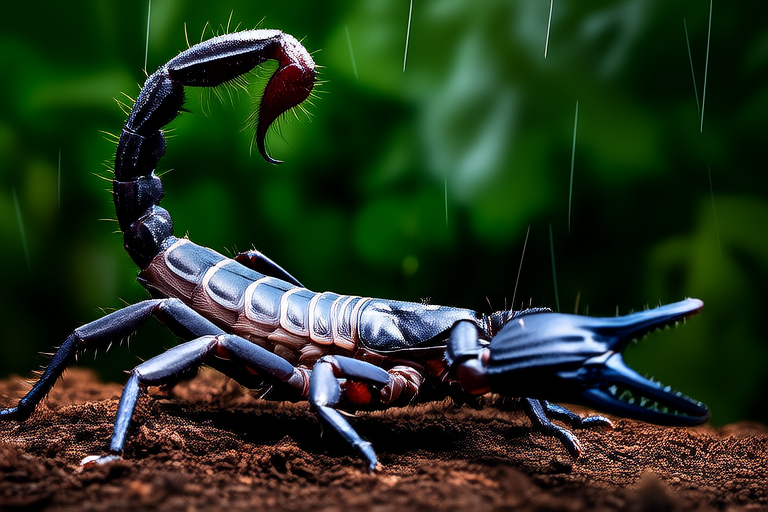
Unveiling the Secrets of Heterometrus Spinifer: A Close Encounter with Nature
In the vast tapestry of Earth’s biodiversity, few creatures captivate the imagination quite like the Heterometrus Spinifer, a scorpion that embodies both mystery and wonder. This article delves into the world of this fascinating arachnid, exploring its classification, physical attributes, behavior, and ecological significance.
Classification and Distinctive Features
The Heterometrus Spinifer belongs to the order Scorpiones, a group characterized by their segmented bodies, eight legs, and a pair of pincers known as pedipalps. Within this order, Heterometrus Spinifer stands out due to its robust build and distinctively spiny tail. This scorpion is part of the family Scorpionidae, which includes some of the largest and most impressive scorpions in the world.
One of the most striking features of the Heterometrus Spinifer is its size, reaching lengths of up to 8 inches (20 cm) when fully grown. Its body is covered in a tough exoskeleton, providing protection from predators and harsh environmental conditions. The scorpion’s coloration typically ranges from dark brown to black, offering excellent camouflage in its natural habitat.
Perhaps the most notable feature of the Heterometrus Spinifer is its tail, adorned with sharp spines that give the species its name. These spines are not merely decorative; they serve as effective deterrents against potential threats, often causing significant pain if touched.
Natural Habitat and Preferred Environment
Heterometrus Spinifer thrives in tropical and subtropical regions, particularly in areas with dense vegetation and humid climates. It is commonly found in Southeast Asia, including countries such as India, Malaysia, and Thailand. The scorpion prefers habitats with plenty of hiding spots, such as under rocks, logs, and in burrows.
This species is well-adapted to life in these environments, where it can find shelter during the day and hunt at night. The humid conditions also help maintain the moisture levels in its body, crucial for survival. Despite its preference for humid climates, the Heterometrus Spinifer can tolerate a range of temperatures, making it somewhat adaptable to different environmental conditions.
Behavior Patterns
The Heterometrus Spinifer is primarily nocturnal, emerging from its daytime retreats to hunt for prey during the cooler hours of the evening. Its diet consists mainly of insects, though it may occasionally consume small vertebrates. The scorpion uses its powerful pincers to grasp and crush its prey, injecting venom through its stinger to immobilize larger or more resilient targets.
Despite its formidable appearance, the Heterometrus Spinifer is generally not aggressive towards humans. Most encounters result in no harm, with the scorpion usually retreating rather than attacking. However, it is essential to exercise caution around this species, especially for those who may be allergic to its venom.
Myths and Misconceptions
One common myth about the Heterometrus Spinifer is that it is highly dangerous to humans. While its venom can cause intense pain and localized swelling, it is rarely fatal to healthy adults. Another misconception is that all scorpions glow under ultraviolet light. While many species do exhibit this trait, it is not universal across all scorpions.
Understanding the true nature of the Heterometrus Spinifer helps dispel these myths and fosters a greater appreciation for this remarkable creature. By recognizing the reality behind these misconceptions, we can better coexist with these animals and protect them from unnecessary harm.
Ecological Role and Interactions with Other Wildlife
The Heterometrus Spinifer plays a vital role in its ecosystem, acting as both predator and prey. As a top predator in its habitat, it helps control populations of insects and other small animals, contributing to the balance of the local food web. In turn, the scorpion itself serves as a food source for larger predators, such as birds and reptiles.
Interactions between the Heterometrus Spinifer and other wildlife are complex and dynamic. For instance, certain species of frogs have developed resistance to the scorpion’s venom, allowing them to prey on the scorpion without suffering severe consequences. Such relationships highlight the intricate web of life that exists in these ecosystems.
Contribution to Ecological Knowledge and Conservation Efforts
Studying the Heterometrus Spinifer offers valuable insights into broader ecological processes and contributes to conservation efforts. Research into the species’ behavior, physiology, and interactions with other organisms provides a deeper understanding of how ecosystems function and adapt over time.
Conservationists are increasingly recognizing the importance of preserving habitats that support species like the Heterometrus Spinifer. By protecting these environments, we safeguard not only the scorpion but also the myriad of other species that depend on them for survival. Moreover, the study of such species can inspire innovative approaches to conservation, helping to ensure the long-term health and resilience of our planet’s ecosystems.
In conclusion, the Heterometrus Spinifer is a remarkable creature that embodies the beauty and complexity of nature. By uncovering the secrets of this scorpion, we gain a greater appreciation for the interconnectedness of life on Earth and the importance of preserving it for future generations.




